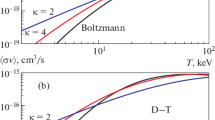Abstract
The Centurion–Halite experiment demonstrated the feasibility of igniting a deuterium–tritium micro-explosion with an energy of not more than a few megajoule, and the Mike test, the feasibility of a pure deuterium explosion with an energy of more than 106 MJ. In both cases the ignition energy was supplied by a fission bomb explosive. While an energy of a few megajoule, to be released in the time required of less than 10−9 s, can be supplied by lasers and intense particle beams, this is not enough to ignite a pure deuterium explosion. Because the deuterium–tritium reaction depends on the availability of lithium, the non-fission ignition of a pure deuterium fusion reaction would be highly desirable. It is shown that this goal can conceivably be reached with a “Super Marx Generator”, where a large number of “ordinary” Marx generators charge (magnetically insulated) fast high voltage capacitors of a second stage Marx generator, called a “Super Marx Generator”, ultimately reaching gigavolt potentials with an energy output in excess of 100 MJ. An intense 107 Ampere-GeV proton beam drawn from a “Super Marx Generator” can ignite a deuterium thermonuclear detonation wave in a compressed deuterium cylinder, where the strong magnetic field of the proton beam entraps the charged fusion reaction products inside the cylinder. In solving the stand-off problem, the stiffness of a GeV proton beam permits to place the deuterium target at a comparatively large distance from the wall of a cavity confining the deuterium micro-explosion.







Similar content being viewed by others
Notes
With a convergent shock wave ignition in the center of the compressed deuterium sphere this energy is less, but even then still much more than a few megajoule.
References
F. Winterberg, Phys. Rev. 174, 212 (1968)
E. Daddario, Environment 11, 32 (1969)
O. Buneman, Phys. Rev. 115, 503 (1959)
L. Davis, R. Lüst, A. Schlüter Z. Naturforsch. 13a, 916 (1958)
F. Winterberg, J. Fusion Energy (2008). doi:10.1007/s10894-008-9185-7
F. Winterberg, J. Fusion Energy 2, 377 (1982)
Acknowledgment
I would like to express my sincere thanks to Dr. Stephan Fuelling for his valuable comments and suggestions, and for the real artwork he has done.
Author information
Authors and Affiliations
Corresponding author
Rights and permissions
About this article
Cite this article
Winterberg, F. Ignition of a Deuterium Micro-Detonation with a Gigavolt Super Marx Generator. J Fusion Energ 28, 290–295 (2009). https://doi.org/10.1007/s10894-008-9189-3
Published:
Issue Date:
DOI: https://doi.org/10.1007/s10894-008-9189-3




